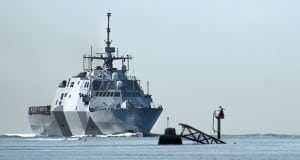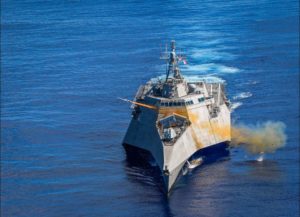A new Government Accountability Office (GAO) report said the Navy needs to do more to address deficiencies and implement a better sustainment approach for Littoral Combat Ships.
“The Littoral Combat Ship (LCS) fleet has not demonstrated the operational capabilities it needs to perform its mission. Operational testing has found several significant challenges,” the Feb. 24 GAO report titled ‘Littoral Combat Ship: Actions Needed to Address Significant Operational Challenges and Implement Planned Sustainment Approach
,’ said.
LCS faces challenges in the ability to defend itself, failure rate of mission-essential equipment, the program is behind schedule in developing mission modules, and GAO found the class “has frequently encountered challenges during deployments.”
While the Navy has started taking steps to address some of these issues, “it does not have a comprehensive plan to address the various deficiencies identified during testing and deployments, GAO said.

GAO said that while the Navy has implemented eight of the 10 recommendations from a 2016 Navy review team and revised the original maintenance approach by replacing contractors with Navy personnel for maintenance on the sea frames, “the Navy is facing challenges in implementing this approach.”
Indeed, the two 2016 recommendations not fully completed are establishing and resourcing LCS maintenance teams and creating blue/gold-plus rotational crewing with dedicated training ships.
According to the report, the Navy has had challenges in determining the right number of maintenance teams; defining their necessary missions, functions, and tasks; determining how to obtain technical data Navy personnel need to perform the tasks; and determining the degree to which maintenance teams can feasibly be used to fill LCS crew vacancies.
The service’s original approach to maintain the LCS seaframe was to mostly rely on contractors serving on fly-away teams that travel overseas to perform any needed maintenance so the LCS crews carry out missions while deployed. After the 2016 review, the Navy recommended and started the process to resource Navy maintenance teams to work on the ships while they are deployed.
Service officials told GAO the Navy will keep adding maintenance teams to the LCSs through fiscal year 2024 but will not be fully established until FY ‘26.
The report also underscored that while LCS has not yet met operational testing requirements, some ships have been deployed overseas with ship crews reporting major challenges in lessons learned and post-deployment documents. These were divided into design, navigation and engine propulsion issues.
Design challenges in the Independence-variants caused docking problems in some foreign ports; the aluminum hull reportedly makes the ships susceptible to damage when getting refueled or passing through the Panama Canal since they do not have adequate fenders or bumpers to protect the ship.
The LCS also relies exclusively on electronic navigation without paper charts. However, some ports and littoral areas the ship must pass through are not transited frequently and the electronic system may not be up to date. GAO says the USS Coronado (LCS-4) crew reported the ship did not have the most up to date charts for several ports of call, with their digital charts not accurately reflecting dangers in restricted waters.
Engine propulsion challenges have also dogged Freedom-variant LCSs for well over a year. Last year, the Navy stopped accepting those variant ships due to a material defect with the combining gear until the fix was installed and tested (Defense Daily, Jan. 22, 2021).
This January, Capt. Andy Gold, program manager for the LCS program, PMS-501, said the Navy was rolling out the fix to new ship construction and is negotiating with prime contractor Lockheed Martin [LMT] on cost sharing for the fix (Defense Daily, Jan. 18, 2022).
Last August, a Navy official said deployed Freedom-variant ships may have to wait years to receive their fix, which prevents them from moving at maximum speeds (Defense Daily, Aug. 3, 2021).
GAO said their assessment found the propulsion system “has caused major challenges for LCS on deployments, with engine failures occurring on 10 out of 11 deployments to date.”
The Navy has started taking steps to address these kinds of issues with pre-deployment assessments.
“However, the Navy does not have a comprehensive plan, including estimated costs and time frames, for addressing the deficiencies identified from operational testing and evaluation for the seaframes; performing adequate operational testing and evaluation of the mission modules to demonstrate their operational and warfighting capabilities; and fully implementing lessons learned from LCS deployments related to design, navigation, engine propulsion, and other operational issues,” the report said.
The office of the Director, Operational Test and Evaluation (DOT&E) told GAO without the comprehensive plan they have not been able to evaluate whether the Navy has remediated challenges it identified to operational effectiveness or suitability of seaframes.
Navy officials said they coordinate with DOT&E to implement recommendations and address deficiencies, but the report said “these officials could not provide documentation to show that these recommendations had been implemented, or that they planned to address these deficiencies.”
DOT&E officials told GAO that, in reality, the LCS program office does not generally respond to the recommendations or deficiencies from its annual reports.
“Without such a comprehensive plan, the LCS will remain at risk of being unable to operate offensively or in high-threat environments—as its operating environment guidance requires—thus jeopardizing its ability to operationally deploy,” the report said.

“Unless the Navy tests and implements solutions to significant operational challenges, the LCS will likely continue to face significant challenges in detecting, countering, and surviving threats in combat; navigating in the littorals; navigating through confined bodies of water, such as the Panama Canal; avoiding hull damage; docking at some foreign ports; or remaining in port under challenging force protection conditions,” GAO added.
The report said that until the Navy makes LCS operational deployments based on improvements in required capabilities LCSs will be dependent in combat and require protection by either multi-mission combatants or multiple LCSs with mutual support.
GAO made six recommendations to the Navy, which it largely concurred with. The first recommendation is for the Navy Secretary to have the Chief of Naval Operations (CNO) conduct a study to determine the appropriate number of maintenance teams and personnel, a feasible set of tasks to be performed by the teams, how to obtain technical data needed to perform maintenance and how to use the teams to fill vacancies on LCSs.
The other recommendations for the Navy Secretary are to ensure the CNO assesses the implications of the Navy’s revised maintenance approach to LCS seaframes on future operating and support costs; have Naval Sea Systems Command update the cost estimates for the LCS to include operating and support costs, incorporate data from completed deployments, and reflect current and planned revised operational and sustainment concepts; have the Program Executive Office for Unmanned and Small Combatants report complete and accurate operating and support cost data in the Navy Visibility and Management of Operating and Support Costs (VAMOSC) information system for LCS mission modules on a per ship and mission module basis; ensure the LCS program office develops a comprehensive plan with estimated costs and time frames to address deficiencies in the seaframes as well as perform adequate testing of mission modules and implement lessons learned from finished deployments; and ensure the CNO makes future operational deployments contingent on demonstrated progress in addressing gaps from demonstrated to desired capabilities.